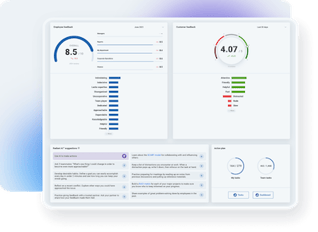
AI Secrets to Achieving Perfect Contact Center Quality Assurance
"Depending on which study you believe, and what industry you're in, acquiring a new customer is anywhere from five to 25 times more expensive than retaining an existing one." This quote brings us to contact centers—widely regarded as the "most frequent customer interaction touchpoint" in many businesses today. They can directly sway customer perceptions and tip the scale to favor repeat purchasing (versus jumping ship to a competitor). The reality is, contact centers can shape the customer experience (CX) and drive your customer retention rate (CRR)—the percentage of customers you convert to brand loyalty in a fixed period. In short, contact centers are at the core of sustaining market share and growth, confirming they're far more than only support hubs in strategic and Customer Relationship Management (CRM) conversations.
Cutting-edge customer service management must prioritize quality assurance (or QA), which revolves around monitoring and evaluating agent/customer interactions using standardized, measurable, and replicable service metrics. QA covers your call center team meeting day-to-day, compliance, legal, and company regulations as a minimum requirement. However, beyond this, QA performance metrics for call centers pave the way to guaranteeing five-star agent performance that delivers consistently positive customer interactions.
Artificial Intelligence plays a crucial role in call center performance fundamentals such as customer satisfaction strategies, customer feedback management, effective contact center coaching, and more. This article will demonstrate how AI addresses traditional quality assurance pain points that hinder call center performance. Discover how AI functions in a fraction of human process time, kicks limited scalability to the curb, and effectively addresses "iffy" people-centric evaluations.
Finally, learn how systems like Macorva's Customer Call Scorecards are significantly enhancing performance management and feedback in call centers. By leveraging AI to integrate sentiment analysis and automated call monitoring, this modern technology is just one of the secrets to achieving perfect contact center quality assurance and an exceptional customer service experience.
To learn more, read on.

The Challenges of Traditional Quality Assurance
Today’s marketing insights emphasize that a strong customer service experience is essential for driving ROI. If you agree, regard your call center as an invaluable asset with all the attributes that make an engaging CX in every segment a reality.
So, in the fast-paced digital era and the eCommerce revolution hitting the 2020s and beyond, there’s no room for inflexible scales of operation or human error in evaluating key metrics. Labor intensive quality management processes that can’t keep up with market opportunities are also unacceptable.
Here are the main obstacles to achieving QA proficiency for companies that haven't adopted real-time call monitoring with AI technologies:
- Time pressure is a constant headache: Online inquiries, requests, and chats involving technical support, emails, complaints, online or brick-and-mortar sales, returns, appointment setting/changing/canceling, exiting or pausing subscriptions, etc., trigger an overwhelming data volume.
- Data and call center analytics:
- Sorting the data—deciding what’s relevant to what decision category—can be severely confusing.
- Verifying the data validity is another responsibility that connects to the old adage “garbage in, garbage out,” which you want to avoid at all costs.
- Even if the data is relevant and accurate, misinterpretation based on human subjectivity spoils the results.
- Agent pushback against constant human scrutiny often stems from concerns around privacy interference.
- Outdated, non-AI-centric software struggles to address key pain points and offers a shrinking set of practical features.
- Outsourcing call center activity (business process outsourcing or BPO): It's a valid option for many but can be severely problematic from a QA viewpoint. Why? You must partner with a BPO that can meet your prescribed standards, ensuring it checks all the boxes in the QA proficiency list above.
How AI Enhances Call Center Performance
Advanced AI technology opens organizations to real-time insights and effective call center coaching that are unattainable by adapting traditional quality assurance methods. You'll realize a double-whammy benefit that will enhance customer experience touchpoints seamlessly and effortlessly, thus uplifting employee engagement in call centers (i.e., your agents) beyond expectations. The big question is how?
Marcorva’s Call Scorecards are an excellent example of what transforming from traditional to AI-driven quality assurance can achieve. Consider that the company’s proprietary software will provide the following (among numerous compelling benefits):
- Automation as a foundational feature in primary activities such as monitoring, analysis, and daily/weekly/monthly reporting with agent over- and under-performance ratings.
- Balanced and unbiased performance evaluations based on integrated data.
- Highlighted touchpoint gaps and defects that obstruct or slow down the customer journey.
- An inward-looking feature that summarizes all service agent feedback to measure the call center team's engagement level and ability to handle customer interaction pressure.
- Broad Employee Experience (EX), Customer Experience (CX), and Manager Experience (MX) verticals that connect to the Call Insights platform, therefore optimizing its resource pool to deliver meaningful solutions in this arena.

Act on your customer data immediately
Receive personalized action plans for every customer interaction directly in your inbox. See how it works
While Macorva's advanced analytics represent a significant improvement over manual methods, a closer look at the software's AI capabilities further underscores its value in achieving comprehensive and efficient call center quality assurance.
1. Real-Time Call Center Analytics for Improved ServiceWe've underlined it in the content above, but it's worth repeating under this heading. Fast-driving change fuels a dynamic call center environment. For example, learning on Thursday or Friday what agents performed poorly on Wednesday can result in hundreds of lost customers and diminishing profitability (never to be recovered). Compare that to software support that feeds insightful metrics to your team in real-time (i.e., at the most, minutes after a crucial touchpoint event), signaling a disruptive issue and giving the agents a cue to adjust their approach for subsequent interactions. In short, real-time reporting removes the frustrating problem of outdated reports with results no longer relevant to changing market conditions.
For example, an emerging Upwork competitor (let’s call it Apex) discovered:
- Call-ins within minutes of promotional SM ads overwhelmed its call center.
- The automated real-time call monitoring analysis showed wait times spiking to over thirty minutes from an average of three.
- Sentiment readings (see more on this below) indicated significant frustration and anger in prospective freelancer and client reactions, coinciding with disappointing sign-ups.
Situations like this are severe customer experience management (CEM) crises, requiring immediate—not delayed—operational revisions. The real-time benefits helped Apex in two substantial respects:
- Instead of wasting the PPC (pay-per-click) budget, Apex pulled the ads, in turn protecting the ad ROI.
- Their strategic planning included forming a reliable partnership with with a BPO call center ready to handle the overflow should the real-time analytics software trigger similar alerts during future ad campaigns.
![]()
2. Comprehensive Analysis of Customer Interactions
A. Brand image and sentiment analysisCX proponents strongly advocate that marketers should appreciate how customers think and probe the emotions behind their behavior. Why? Most marketplaces generally reflect fine-tuned competitive product presentations so detailed that the differences in blind functional testing are indistinguishable. So, what does this leave us as a differentiator? Brand image—a much-heralded and decisive weapon for creating an emotional and cognitive connection with customers.
A good example is the millions of consumers who buy only Nike shoes, apparel, and sports equipment. That's because following one's instincts, taking the bull by the horns, and "just doing it" (as Nike advocates in its vision) is psychographically satisfying. Who makes this notion credible? Sports stars like Rafa Nadal (tennis), Michael Jordan (basketball), Tiger Woods (golf), Sha'carri Richardson (athletics), and dozens more aspirational influencers are living proof that "just doing it" succeeds spectacularly.
B. Marketers who ignore sentiment do so at their peril.The need for professional sentiment analysis in call centers cannot be over-emphasized. A widely applauded report surveying 125 organizations reflected that only 30% of those surveyed matched customers’ expectations. Other reputable sources highlighted the following:
- Around 80% of consumers are ready to switch brands following only two disappointing brand experiences, whereas 65% of customers followed suit after only one lousy brand experience.
- According to Ruby Newell-Legner’s "Understanding Customers," it takes 12 consecutive positive customer experiences to make up for a negative one.
- Companies with exceptional overall service will still lose 22% of their customers with a single touchpoint misstep (Salesforce Research).
- Attracting new customers costs 5x to 25x more than retaining loyal ones.
- According to Khoros, 83% of customers remain brand loyal if the company responds promptly to their complaints.
- Businesses that are touchpoint-conscious, intent on delivering a fantastic CX, outdo competitors by 4 to 8% market growth over competitors in the same marketplace. (Bain & Company)
C. Who’s leading the call center sentiment race?
Macorva and other leading software providers have gone the extra mile to develop comprehensive sentiment analysis for call centers. These tools drive initiatives to enhance customer experience, using customer satisfaction strategies that help maintain a competitive edge.
They evaluate emotional temperature, cognitive performance, and break-or-make (i.e., high-intensity) moments in every interaction. Other aspects include vital performance metrics (see more on this below) collected from diverse and expansive data in a fraction of human time that cover:
- Several types of post-call surveys, including CSAT (Customer Satisfaction), NPS (Net Promoter Score), CES (Customer Effort Score), and qualitative questionnaires.
- Customer emails, SM reviews, and complaints.
- Reviewing call recordings of chats across the board using conversation analytics software centered on technologies such as Natural Language Processing (NLP) or Natural Language Understanding (NLU).
- Deploying such cutting-edge tools as multilingual text analysis, social media monitoring tools, and advanced NLP multi-channel data collection algorithms.
A note on performance metrics for call centers
Macorva's AI-driven systems extract data from every customer/brand interaction and objectively score them. It occurs before providing real-time recommendations to remedy negative sentiments or capitalize on positive ones. These personalized insights are the result of a balanced integration of AI Agent Scorecards and widely used call center metrics, such as:
- The Net Promoter Score that measures the likelihood a customer will recommend the company to friends after a call center experience.
- The Customer Satisfaction Score and Customer Effort Score—different numerical ratings of customer touchpoint satisfaction.
- Average Speed of Answer (ASA) and Average Handling Time (AHT)
- Call Abandon Rate.
The net result is a holistic view of agent performance, pinpointing top performers, recognizing and ranking improvement areas, and streamlining performance reviews.
3. Personalized Coaching, Development, and Employee Engagement in Call Centers.Agent quality is at the heart of call center viability and performance. As a result, employee engagement and capability must be a top CEM priority, requiring skills development and training that's not only focused on call center job descriptions but also customized to account for team member personalities.
Fine-tuning to this degree is the essence of targeted, AI-driven, agent-personalized coaching plans (such as those offered by Macorva). Developed through modern AI technologies, these development resources connect your team to quick, effective learning method. They ensure fast progress by identifying specific areas for improvement and highlighting strengths and weaknesses in each call.
The primary feature of modern QA coverage (energized by AI) is a complete end-to-end overview of every customer interaction—service calls, follow-up surveys, emails, texts, complaints, and reviews. In other words, it’s a program that omits nothing.
Marcorva meets these call center performance standards and goes beyond traditional, human-reliant quality assurance by enabling real-time call monitoring on a scalable level. One key feature highlights high-impact interactions in real-time, allowing for quick adjustments when needed. This smart filtering ensures that the most important interactions are prioritized, maximizing the effectiveness of your quality assurance efforts.
5. Integration with existing systemsCall center software providers must recognize that their clients are ongoing entities with infrastructures, protocols, existing teams, training programs, and associations geared to current operations. Introducing automated call monitoring and other AI innovations that create internal disruption is unlikely to be welcomed. So, integration with other platforms the team might already be using is a crucial consideration when presenting call center customer satisfaction strategies.
Macorva exemplifies this approach by covering all the essentials. It focuses on helping even the most traditional QA clients smoothly transition into the AI era, integrating seamlessly with existing systems rather than requiring a complete digital overhaul.
6. Data Privacy and SecurityCall centers are prime targets of hackers and sophisticated cybersecurity criminals. As a result, regulations and compliance have tightened up, providing a secure call center software foundation that revolves around customer feedback management, scanning data, and covering customer/employee IDs. When looking for a solution, it's crucial to choose software that offers SOC 2-certified benefits, ensuring full GDPR and HIPAA compliance. This means you can be confident in having unsurpassed data privacy and secure touchpoints, no matter how the software is deployed.
Statistics show that AI-driven Call Center Performance really works.
A reliable statistical source, gathering data from customer service agents and specialists, offers insights into AI software that enhances client contact center strategies. There are benefits and potential drawbacks, but the positives overwhelmingly outweigh the negatives. Judge for yourself from the following:
The Pros:
- 91% of clients using AI as support are satisfied with the results.
- 56% are optimistic that upgraded technology will enhance their success (versus the previous year).
- The percentage of respondents highlighting exceptional AI advantages were as follows:
- Conversational AI and chatbots have boosted productivity - 94%.
- Defective touchpoint resolution has speeded up - 92%.
- Reduced agent stress - 87%.
- Improved consumer service - 69%.
- Higher efficiency resulting in lower costs - 65%.
- Reduced wait times - 55%.
- Defined, streamlined, and tighter workflows - 54%.
- Improved customer satisfaction - 48%.
- More focused application of data and analytics - 41%
- Respondents directly involved in measuring call center metrics observed the following (on average):
- 27% handle time reduction.
- 34% revenue increase.
- A 40% jump in favorable client reviews.
- 32% team member productivity upliftment.
- Bottom line savings (considering all contributors) of $4.3 million staffing cost savings for the average company in the survey.
The Cons:
- AI still needs to deliver an unblemished personal experience - 45%.
- Some inaccuracies in AI tools (although becoming less frequent) - 40%
- Fear of being squeezed out of a job by AI - 39%
- It’s challenging to integrate AI into the existing infrastructure - 32%
- Afraid of over-dependence on technology - 30%.
- Affordability is a concern - 23%.
Neutral but interesting statistics
In an aligned survey (by the same researcher)—focused on call center customers and management—the following emerged:
- Clients who prefer interaction with agents over AI - 46%
- Clients who find robotics and AI chat less personal than human service - 30%
- Businesses and consumers mutually agreeing to disclose AI use in client care situations - 90%.
- Businesses and consumers who agree on human monitoring of AI - 77% and 73%.
Leading contact center software providers, like Macorva, proactively address these considerations by continuously refining their solutions with thoughtful updates and innovative features.

A look at AI’s future in Call Center Quality Assurance
By the end of 2024 (entering 2025), business stakeholder consensus suggests that AI automation will be increasingly integrated into the software, including Generative AI and chatbots. Nearly 50% of customer service professionals believe that AI can independently handle almost 100% of customer service tasks. Across numerous white papers and expert analyses, the indications are that AI in call centers will continue to gain traction. It will do what it already does, except faster, more accurately, with higher ROIs, achieving new levels of sophistication, pushing automation to new levels. Much of that is thanks to AI being injected into software testing (a massive overhead item previously relying on only human involvement), cutting substantial costs and time out of the equation.
From a customer’s viewpoint, without directly attributing it to AI, they’ll participate in significantly reduced:
- Wait times.
- Time gaps in support services.
- Frustration with agent incompetence.
Simultaneously, they’ll become accustomed to substantially increased:
- Chat engagement by phone and online.
- Automation from corner to corner of call center touchpoints.
- Humanization of bot interactions.
- Brand responsiveness to surveys and reviews.
- Overall support service quality
Forrester predicts that 60% of Gen AI skeptics use it—frequently without knowing it. Gartner forecasts that by 2026, customer services will enjoy $80 billion in reduced center labor costs thanks to conversational AI advances.
Conclusion
The insights provided in this article show that quality assurance in call centers and AI initiatives impact CX. So, the question isn't if AI technology will enter your customer satisfaction strategies but how seamlessly and effectively you can integrate it.
A key example of this integration can be seen in Macorva’s call center software, which includes:
- AI-centric data analysis that supplies managers with real-time customer interaction feedback from every virtual quarter, generating sentiment metrics and agent scores. This allows users to:
- Erase disruptive touchpoints with stunning adaptability and flexibility.
- Engage employees and consumers to elevate team support wherever and whenever needed.
No matter how advanced the program, our call center solutions integrate seamlessly with your existing systems. Contact Macorva to request a demo and discover how our technology can help you meet your customers' needs and deliver the exceptional support they demand with every brand interaction.








